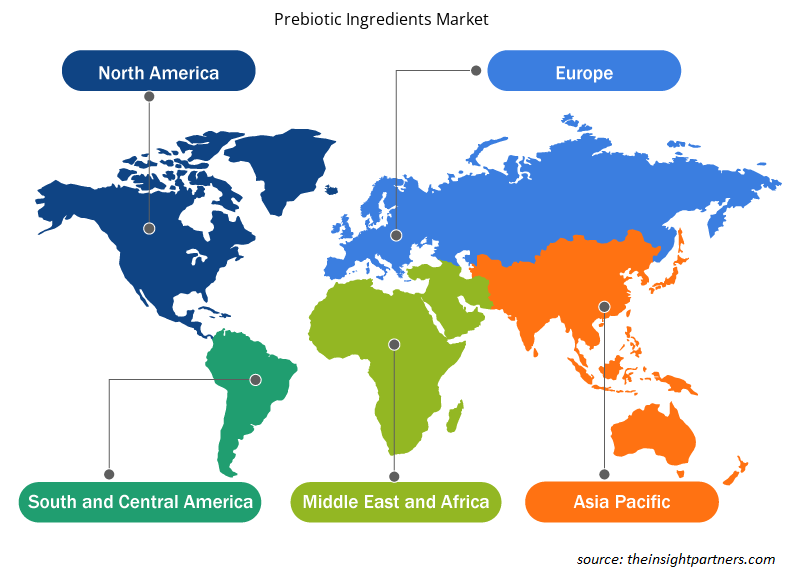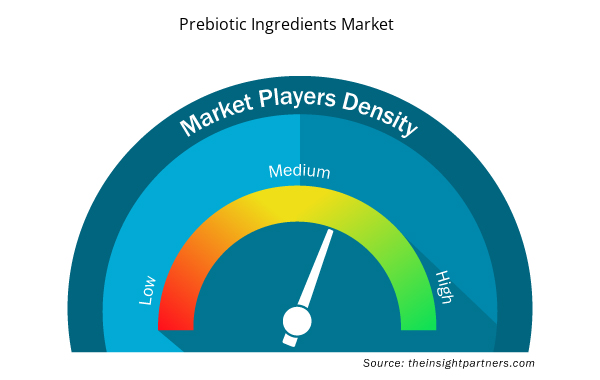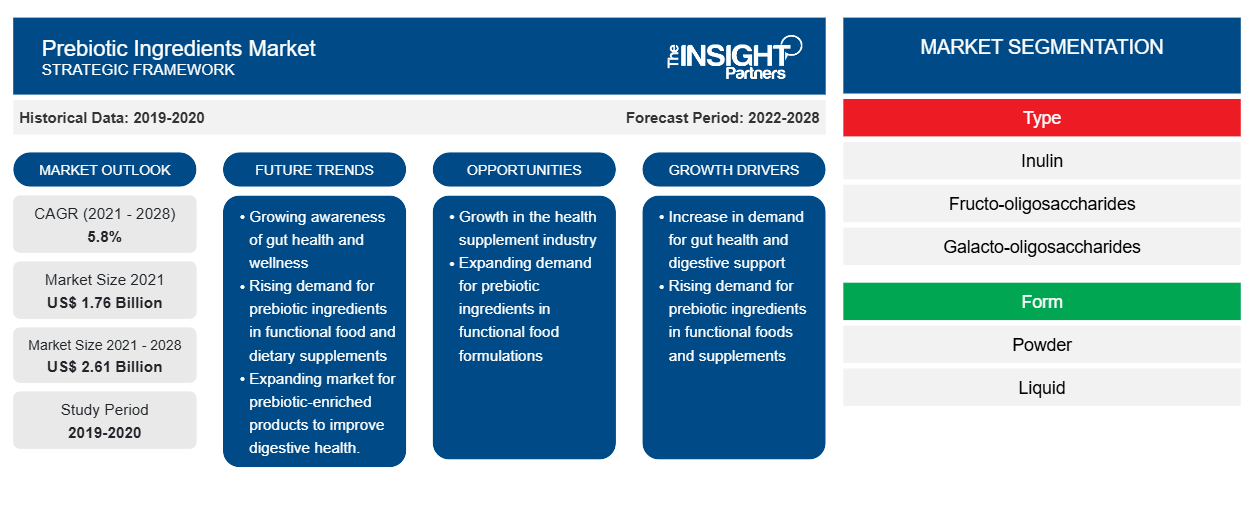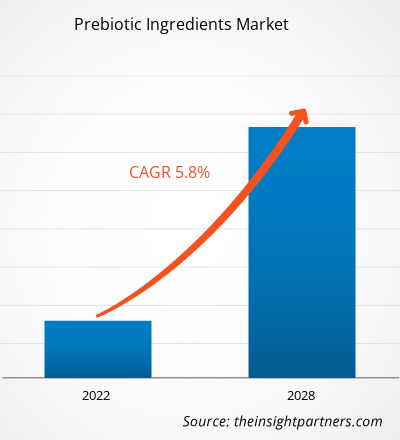[研究报告]益生元成分市场预计将从 2021 年的 17.584 亿美元增长到 2028 年的 26.0772 亿美元;预计2022 年至 2028 年的复合年增长率为 5.8%。
益生元是食物中诱导有益微生物(如细菌和真菌)生长或活动的化合物。发酵是有益细菌在结肠中利用益生元的主要作用机制。益生元在预防保健中发挥着重要作用,因为富含纤维的营养补充剂在体育爱好者和运动员中越来越受欢迎,以增强他们的体力和耐力,这进一步推动了对益生元成分的需求。因此,对预防保健的认识不断提高,正在推动益生元成分市场的增长。
2021 年,亚太地区占据了益生元成分市场的最大份额,而中东和非洲等其他发展中地区预计在预测期内将大幅增长。市场增长归因于肠道健康和免疫健康障碍的增加以及消化系统疾病的增加。亚洲国家倾向于采用健康营养的食品和饮料来改善肠道健康。因此,对健康食品的倾向正在推动益生元成分市场的增长。
定制此报告以满足您的需求
您可以免费定制任何报告,包括本报告的部分内容、国家级分析、Excel 数据包,以及为初创企业和大学提供优惠和折扣
- 获取此报告的关键市场趋势。这个免费样品将包括数据分析,从市场趋势到估计和预测。
COVID-19 疫情对益生元成分市场的影响
2020 年初,COVID-19 疫情给许多行业带来了前所未有的挑战。各国政府根据世卫组织和各国卫生部的指导方针采取的封锁、边境限制、旅行禁令、生产停工和其他安全措施阻碍了制造业的运营。然而,COVID-19 疫情对市场产生了积极影响,因为越来越多的消费者开始寻求天然、更安全的替代品来保持健康并增强免疫系统。在 COVID-19 疫情爆发的最初几个月,对膳食补充剂的需求急剧增加。此外,由于政府要求人们待在家里,他们注重健康和健身,刺激了COVID-19 疫情期间对益生元的需求。
市场洞察
食品和饮料行业对益生元成分的需求不断增长
益生元在食品和饮料行业越来越受欢迎,因为它们被应用于营养棒、乳制品、健康饮料、矿物质补充剂、早餐麦片、烘焙食品、糖果、绿色食品和婴儿配方奶粉中。2018 年 11 月,家乐氏公司推出了一款名为 HI! Happy Inside 的新麦片,其中包括益生元和益生菌,作为其肠道促进消化产品系列的一部分。此外,菊粉被广泛用于食品加工,因为它是脂肪和糖的良好健康替代品。美国、印度和中国等主要产奶国利用益生元为最终产品提供所需的质地,并生产无糖乳制品。此外,婴儿配方奶粉或婴儿食品含有各种益生元成分,包括半乳寡糖、果寡糖和聚葡萄糖。这些都是推动益生元成分市场增长的因素。
基于类型的洞察
根据类型,益生元成分市场细分为菊粉、低聚果糖 (FOS)、低聚半乳糖 (GOS)、低聚甘露糖 (MOS) 等。菊粉部分预计将在预测期内占据最大份额。制造商将其用于加工食品和饮料、膳食补充剂和动物饲料中,以替代糖、脂肪和面粉。在美国,2018 年,食品和药物管理局批准菊粉作为膳食纤维成分,以提高制成食品的营养价值。此外,对天然产品的不断增长的需求增加了全球对益生元菊粉的需求。菊粉部分的增长是由各个行业中应用的不断增加推动的,从而推动了益生元成分市场的增长。
基于表单的洞察
根据形式,益生元成分市场分为粉末和液体。预计在预测期内,粉末部分将在市场上实现更高的复合年增长率。粉末形式使益生元的分配和利用变得容易。使用益生元粉末进行畜牧生产的好处越来越受欢迎,因为粉末益生元可以在牲畜生命的任何阶段食用。此外,肉类、蛋类和牛奶产量的提高也增加了对粉末益生元的需求。
基于应用的洞察
根据应用,益生元成分市场细分为功能性食品和饮料、膳食补充剂、动物饲料等。膳食补充剂部分预计将在预测期内实现最高的复合年增长率。预防药物需求的增加、老年人消化系统疾病的增加以及饮食不均衡可能会增加膳食补充剂行业的产品需求。由于不健康饮食的日益盛行,消费者越来越喜欢基于益生元的食品补充剂。
益生元成分市场的主要参与者包括 BENEO GmbH、COSUCRA、杜邦营养与生物科学公司、Clasado Ltd.、Nexira、Ingredion Incorporated、SOLACTIS、Cargill, Incorporated.、Sensus 和 Roquette Frères。这些参与者致力于开发降低健康风险的产品,以满足新兴的消费趋势并遵守监管框架。他们参与并购、业务扩张和合作,以扩大其市场份额。
益生元成分市场区域洞察
Insight Partners 的分析师已详细解释了预测期内影响益生元成分市场的区域趋势和因素。本节还讨论了北美、欧洲、亚太地区、中东和非洲以及南美和中美洲的益生元成分市场细分和地理位置。

- 获取益生元成分市场的区域特定数据
益生元成分市场报告范围
| 报告属性 | 细节 |
|---|---|
| 2021 年市场规模 | 17.6亿美元 |
| 2028 年市场规模 | 26.1亿美元 |
| 全球复合年增长率(2021 - 2028) | 5.8% |
| 史料 | 2019-2020 |
| 预测期 | 2022-2028 |
| 涵盖的领域 | 按类型
|
| 覆盖地区和国家 | 北美
|
| 市场领导者和主要公司简介 |
|
益生元成分市场参与者密度:了解其对业务动态的影响
益生元成分市场正在快速增长,这得益于终端用户需求的不断增长,而这些需求又源于消费者偏好的不断变化、技术进步以及对产品益处的认识不断提高等因素。随着需求的增加,企业正在扩大其产品范围,进行创新以满足消费者的需求,并利用新兴趋势,从而进一步推动市场增长。
市场参与者密度是指在特定市场或行业内运营的企业或公司的分布情况。它表明在给定市场空间中,相对于其规模或总市场价值,有多少竞争对手(市场参与者)存在。
在益生元成分市场运营的主要公司有:
- 贝尼奥有限公司
- 柯苏克拉
- 杜邦
- 克拉萨多有限公司
- 耐西拉
免责声明:上面列出的公司没有按照任何特定顺序排列。

- 获取益生元成分市场顶级关键参与者概览
报告亮点
- 益生元成分市场不断发展的行业趋势,帮助参与者制定有效的长期战略
- 采取业务增长战略以确保发达市场和发展中市场的增长
- 2022 年至 2028 年益生元成分市场定量分析
- 全球益生菌需求量估计
- 波特五力分析说明了行业内买家和供应商的效力
- 了解竞争市场状况的最新发展
- 市场趋势和前景,以及影响益生元成分市场增长的因素
- 通过强调支撑商业利益的市场策略来协助决策过程,从而促进市场增长
- 益生元成分市场不同节点的规模
- 市场和益生菌行业动态的详细概述和细分
- 各地区增长规模及增长机遇
- 历史分析(2 年)、基准年、预测(7 年)及复合年增长率
- PEST 和 SWOT 分析
- 市场规模价值/数量 - 全球、区域、国家
- 行业和竞争格局
- Excel 数据集



Report Coverage
Revenue forecast, Company Analysis, Industry landscape, Growth factors, and Trends

Segment Covered
This text is related
to segments covered.

Regional Scope
North America, Europe, Asia Pacific, Middle East & Africa, South & Central America

Country Scope
This text is related
to country scope.
常见问题
Increasing consumers’ focus on preventive health driving global prebiotic Ingredient’s market. Over the past few years, the awareness regarding health and nutrition has increased significantly. Because of hectic work schedules and extended working hours, people pay less attention to their daily diet, health, and fitness. Ignorance about proper diet may lead to various health issues such as obesity, diabetes, and digestive problems. This drives people’s focus toward preventive health and dietary supplements that offer health benefits without harmful effects. Prebiotics-infused supplements are known for their ability to nourish human gut flora and significantly boost their metabolic activity, hence improving digestion, nutrition absorption, and immune systems while inhibiting harmful microbe growth. Mannan-oligosaccharides (MOS) are a special prebiotic ingredient that interferes with the binding and colony formation of pathogens. Thus, it acts as a blocking agent in the intestinal area. Moreover, prebiotic supplements may offer health benefits, such as decreasing anxiety and alleviating irritable bowel syndrome (IBS) symptoms. A healthy digestive system has been linked to mental health and immune response improvements. These factors are significantly boosting the demand for such ingredients among consumers, eventually boosting the growth of the prebiotic ingredients market.
Based on the application, functional food & beverages segment is projected to grow at the fastest CAGR over the forecast period. The growing popularity of functional food & beverages driving the prebiotic ingredients market. The increasing demand for functional food is due to increased health issues among the population. This is due to the increasing consumption of functional foods to maintain & promote the gut health. Hence the rising diseases & health issues further projected the rise in demand for functional foods during the forecast period.
Further, the fortified foods are gaining popularity across the globe owing to the increased awareness of benefits among the population. Fortified foods usually produced with adding nutrients in it. Hence, the adding of essential nutrients tends to prevent the chronic diseases such as diabetes, heart diseases, and cancer. Hence, the consumption of fortified food is increasing worldwide, and further fueling the prebiotic ingredients market.
Asia Pacific accounted for the largest share of the global prebiotic Ingredients market. Asia Pacific prebiotic ingredients market is segmented into China, India, Australia, Japan, South Korea, and the Rest of Asia Pacific. The market growth is attributed to increasing gut health and immune health disorders coupled with growing digestive diseases. The Asian countries are inclining toward adopting healthy and nutritious food items and beverages to improve gut health. Hence, inclination towards adopting healthy food is driving the growth of the prebiotic ingredients market. Further, the growing awareness about the health benefits of prebiotics in animal health are creating substantial demand for prebiotic-based feeds such as lactulose, mannan-oligosaccharide (MOS), inulin, soy fructo-oligosaccharide (FOS) and galacto-oligosaccharide (GOS). As livestock and farm animals contribute significantly to the food supply chain, the demand for prebiotic-rich animal feeds is expected to grow during the forecast period.
The major players operating in the global prebiotic Ingredients market are Beneo GmbH; COSUCRA; DuPont; Clasado Limited; Nexira; Ingredion; Solactis; Cargill, Incorporated; Sensus; Roquette Freres.
Rising demand for prebiotics in animal feed anticipate lucrative opportunities for the prebiotic ingredients market. Animal feed with prebiotics as an additive has been shown to increase the yield. Mannan-oligosaccharides are used in poultry feed as an alternative to antibiotics. Rising cases of digestive disorders in livestock, such as enteric infections and acidosis, further agitate the industry landscape. The numerous advantages of prebiotics on animal health, such as triggered animal growth rate, and milk and egg yield, are anticipated to drive the demand for prebiotics in animal feed.
Based on type, inulin segment has largest revenue share. Inulin is a starchy prebiotic fiber found in various fruits, vegetables, and herbs, including wheat, onions, bananas, chicory, artichokes, and asparagus. Insulins are a group of naturally occurring polysaccharides, a heterogeneous collection of fructose polymers whose flavor ranges from bland to subtly sweet. Manufacturers use it in processed food and beverages, dietary supplements, and animal feed to replace sugar, fat, and flour. In the US in 2018, the Food and Drug Administration approved inulin as a dietary fiber ingredient to improve the nutritional value of manufactured food products. Moreover, the propelling demand for natural products increases the demand for prebiotic inulin worldwide.
Trends and growth analysis reports related to Food and Beverages : READ MORE..
The List of Companies - Prebiotic Ingredients Market
- Beneo GmbH
- COSUCRA
- DuPont
- Clasado Limited
- Nexira
- Ingredion
- SOLACTIS
- Cargill, Incorporated
- Sensus
- Roquette Freres
The Insight Partners performs research in 4 major stages: Data Collection & Secondary Research, Primary Research, Data Analysis and Data Triangulation & Final Review.
- Data Collection and Secondary Research:
As a market research and consulting firm operating from a decade, we have published and advised several client across the globe. First step for any study will start with an assessment of currently available data and insights from existing reports. Further, historical and current market information is collected from Investor Presentations, Annual Reports, SEC Filings, etc., and other information related to company’s performance and market positioning are gathered from Paid Databases (Factiva, Hoovers, and Reuters) and various other publications available in public domain.
Several associations trade associates, technical forums, institutes, societies and organization are accessed to gain technical as well as market related insights through their publications such as research papers, blogs and press releases related to the studies are referred to get cues about the market. Further, white papers, journals, magazines, and other news articles published in last 3 years are scrutinized and analyzed to understand the current market trends.
- Primary Research:
The primarily interview analysis comprise of data obtained from industry participants interview and answers to survey questions gathered by in-house primary team.
For primary research, interviews are conducted with industry experts/CEOs/Marketing Managers/VPs/Subject Matter Experts from both demand and supply side to get a 360-degree view of the market. The primary team conducts several interviews based on the complexity of the markets to understand the various market trends and dynamics which makes research more credible and precise.
A typical research interview fulfils the following functions:
- Provides first-hand information on the market size, market trends, growth trends, competitive landscape, and outlook
- Validates and strengthens in-house secondary research findings
- Develops the analysis team’s expertise and market understanding
Primary research involves email interactions and telephone interviews for each market, category, segment, and sub-segment across geographies. The participants who typically take part in such a process include, but are not limited to:
- Industry participants: VPs, business development managers, market intelligence managers and national sales managers
- Outside experts: Valuation experts, research analysts and key opinion leaders specializing in the electronics and semiconductor industry.
Below is the breakup of our primary respondents by company, designation, and region:

Once we receive the confirmation from primary research sources or primary respondents, we finalize the base year market estimation and forecast the data as per the macroeconomic and microeconomic factors assessed during data collection.
- Data Analysis:
Once data is validated through both secondary as well as primary respondents, we finalize the market estimations by hypothesis formulation and factor analysis at regional and country level.
- Macro-Economic Factor Analysis:
We analyse macroeconomic indicators such the gross domestic product (GDP), increase in the demand for goods and services across industries, technological advancement, regional economic growth, governmental policies, the influence of COVID-19, PEST analysis, and other aspects. This analysis aids in setting benchmarks for various nations/regions and approximating market splits. Additionally, the general trend of the aforementioned components aid in determining the market's development possibilities.
- Country Level Data:
Various factors that are especially aligned to the country are taken into account to determine the market size for a certain area and country, including the presence of vendors, such as headquarters and offices, the country's GDP, demand patterns, and industry growth. To comprehend the market dynamics for the nation, a number of growth variables, inhibitors, application areas, and current market trends are researched. The aforementioned elements aid in determining the country's overall market's growth potential.
- Company Profile:
The “Table of Contents” is formulated by listing and analyzing more than 25 - 30 companies operating in the market ecosystem across geographies. However, we profile only 10 companies as a standard practice in our syndicate reports. These 10 companies comprise leading, emerging, and regional players. Nonetheless, our analysis is not restricted to the 10 listed companies, we also analyze other companies present in the market to develop a holistic view and understand the prevailing trends. The “Company Profiles” section in the report covers key facts, business description, products & services, financial information, SWOT analysis, and key developments. The financial information presented is extracted from the annual reports and official documents of the publicly listed companies. Upon collecting the information for the sections of respective companies, we verify them via various primary sources and then compile the data in respective company profiles. The company level information helps us in deriving the base number as well as in forecasting the market size.
- Developing Base Number:
Aggregation of sales statistics (2020-2022) and macro-economic factor, and other secondary and primary research insights are utilized to arrive at base number and related market shares for 2022. The data gaps are identified in this step and relevant market data is analyzed, collected from paid primary interviews or databases. On finalizing the base year market size, forecasts are developed on the basis of macro-economic, industry and market growth factors and company level analysis.
- Data Triangulation and Final Review:
The market findings and base year market size calculations are validated from supply as well as demand side. Demand side validations are based on macro-economic factor analysis and benchmarks for respective regions and countries. In case of supply side validations, revenues of major companies are estimated (in case not available) based on industry benchmark, approximate number of employees, product portfolio, and primary interviews revenues are gathered. Further revenue from target product/service segment is assessed to avoid overshooting of market statistics. In case of heavy deviations between supply and demand side values, all thes steps are repeated to achieve synchronization.
We follow an iterative model, wherein we share our research findings with Subject Matter Experts (SME’s) and Key Opinion Leaders (KOLs) until consensus view of the market is not formulated – this model negates any drastic deviation in the opinions of experts. Only validated and universally acceptable research findings are quoted in our reports.
We have important check points that we use to validate our research findings – which we call – data triangulation, where we validate the information, we generate from secondary sources with primary interviews and then we re-validate with our internal data bases and Subject matter experts. This comprehensive model enables us to deliver high quality, reliable data in shortest possible time.


 获取此报告的免费样本
获取此报告的免费样本